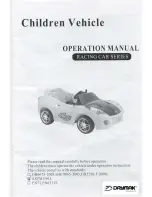
17
CARSON 3D Helicopter Bluster 507012
GB
Tail rotor system check:
1. Make sure the tail gear set is working correctly. There should
be no gaps at the gears and gear mesh should be smooth
with no binding. If there are any teeth missing on the gears
or binding the gears should be replaced before the next
flight.
2. Make sure that there is no grass in the gear system when
flying in grassy areas. Do not oil the exposed gears since
this can attract dirt which will rapidly wear out the gears.
3.Take apart the tail system after 50 flights and clean the gears
and drive train. Inspect the gear set and replace any worn or
damaged gears.
4. Should your helicopter hit the ground hard, inspect for
damage immediately, replace any component that is
damaged with a new part prior to flying again.
Caution:
Check all of the fasteners and screws prior to the start of
a flight, loose screws can cause unexpected accidents and
possible crash or personal injury..
Make sure that nobody else is transmitting in the proximity of
your frequency! Interfering signals on the same frequency can
make you lose control over your model. If you are flying with
other RC users, it might be necessary to change the frequency.
Transmitter
A rapid change of frequencies is possible simply by unplugging
an interchangeable crystal on the back of the transmitter and
then plugging in another one.
For reasons of operational safety, employ only crystals recom-
mended by the suppliers explicitly for use in your remote
control system.
Remove the holder for the transmitter crystal from the back of
the transmitter housing of a switched-off transmitter.
Set the crystal replacement with another channel of the same
frequency band. Pay attention that the correct crystal is
employed. Transmitter crystals are as a rule characterized with
the letters T or TX (T = Transmitter).
Receiver
Plug in an interchangeable crystal into the receiver for a rapid
change of frequencies.
The suitable receiver crystal with the frequency suitable to the
transmitter must be labelled with the same channel number as
the transmitter crystal. It additionally bears the identification
letter R or RX (R = Receiver).
Now take the transmitter and subsequently the receiver into
operation and check the functioning of the equipment.
Do not mix up the transmitter and
receiver crystals!
The transmitter and receiver crystals must be of an identical
frequency.
Make sure that the crystal is fully inserted in the transmitter and
receiver, not partially.
l. How to change frequencies
















































